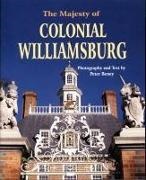Ulteriori informazioni
Photography and text by Peter Beney in association with The Colonial Williamsburg Foundation
In Colonial Williamsburg, a step into the Historic Area means a step back in time. Visitors enter the world of eighteenth-century colonial America, brought to life by reenactors authentically portraying the residents of the period. Explore beautifully recreated and restored buildings, including the Governor's Palace, residence of Thomas Jefferson and Patrick Henry; the Raleigh Tavern, where the Continental Congress was formed and George Washington dined; and the Capitol, where the walls rang with Patrick Henry's "Treason" speech and the 1776 Resolution for Independence was adopted.
For 200 years, many of the historical buildings languished in disrepair. In 1926, the Reverend Dr. W. A. R. Goodwin and philanthropist John D. Rockefeller, Jr., began work to restore Williamsburg, the colonial capital of Virginia and the birthplace of the American Revolution. Today, Colonial Williamsburg is the largest and oldest living history museum in the world, a fully restored town complete with costumed interpreters, craftsmen, and tradespeople, as well as period transportation and livestock.
Through photographs and text, enter the world that forged the identity of these United States of America.
Info autore
When Peter Beney began his career as a photographer in the early 1950s, the profession and its craft were quite developed in most respects, excepting the art of color photography. Over the next four decades, color would have a significant impact on photography, and Beney was one of its premier craftsmen.
Beney began experimenting with color photography in 1954, which, at the time, was relatively uncommon. The processes were crude, intricate, and difficult to manage. Beney soon realized color's importance in this field and devoted himself to learning about different color techniques in order to perfect his craft. Even in his early days as a travel photographer, he used color when others would not risk bringing the delicate process outside of the studio and into an uncontrolled climate.
The photos he has taken during his forty-year career stand as a great contribution to his trade. He worked on commercial and travel shoots through the sixties and later switched completely to travel photography. His travels took him to many places around the globe, and his works appeared in more than 100 books produced by Colour Library in England.
In the eighties, Beney formed his own stock library of more than twenty thousand photographs in Roswell, Georgia, and turned his lens to publishing. He was the chief photographer for the "bid books" for Atlanta's successful pitch to host the 1996 Summer Olympic Games.

